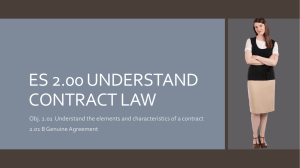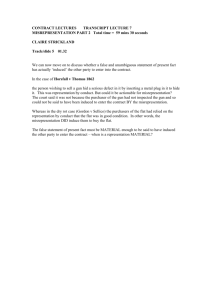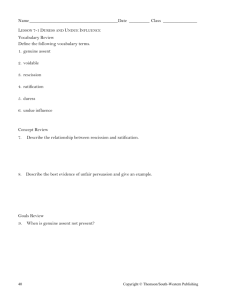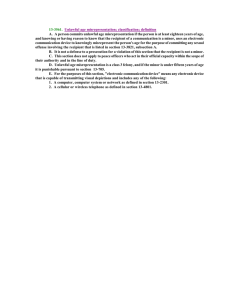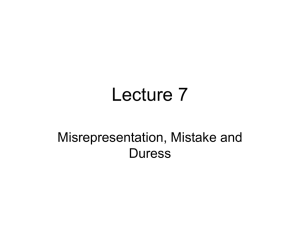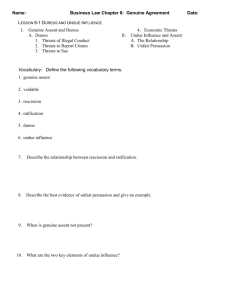Tendering contracts - Electrical and Computer Engineering
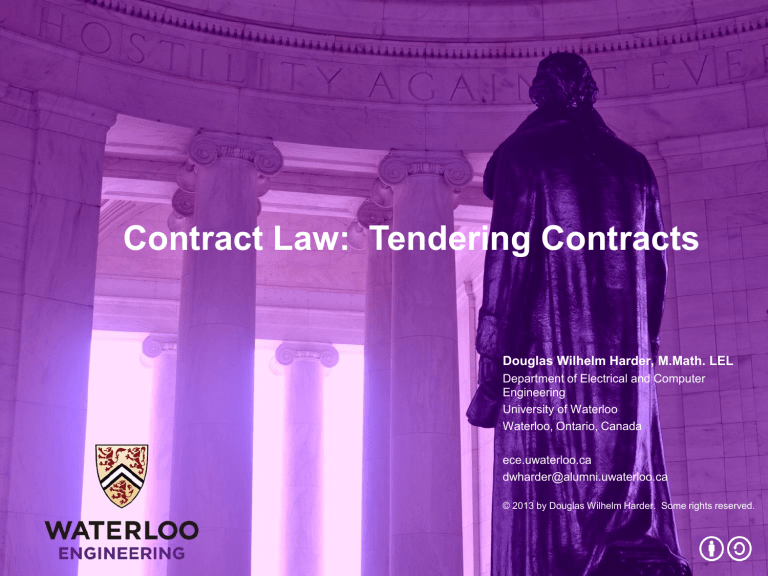
Contract Law: Tendering Contracts
Douglas Wilhelm Harder, M.Math. LEL
Department of Electrical and Computer
Engineering
University of Waterloo
Waterloo, Ontario, Canada ece.uwaterloo.ca
dwharder@alumni.uwaterloo.ca
© 2013 by Douglas Wilhelm Harder. Some rights reserved.
Tendering Contracts
Outline
An introduction to the engineering profession, including:
– Standards and safety
– Law: Charter of Rights and Freedoms, contracts, torts, negligent malpractice, forms of carrying on business
– Intellectual property (patents, trade marks, copyrights and industrial designs)
– Professional practice
• Professional Engineers Act
• Professional misconduct and sexual harassment
– Alternative dispute resolution
– Labour Relations and Employment Law
– Environmental Law
2
Tendering Contracts
Rescission
Once parties enter into a contract, there may be questions of equity where a court will allow a party of the contract to rescind the contract
– This is a remedy for harm caused to one party of the contract
This can be done at any time and it involves the unwinding of the obligations and benefits of all parties
– The goal is to return all parties back to the original state prior
( status quo ante ) prior to the contract
Also called cancellation , reversing , etc .
3
Tendering Contracts
Cause for Rescission
There are numerous cases whereby one party may apply to the courts to rescind a contract:
– Misrepresentation
– Duress
– Economic duress
– Undue influence
4
Tendering Contracts
Misrepresentation
A false statement or a false assertion of a fact is described as a misrepresentation
If one party is influenced by a misrepresentation to enter into a contract, that party can apply for a rescission of the contract
– The deceived party will usually be given the option of voiding the contract —that is, the contract will be made voidable by the courts
5
Tendering Contracts
Misrepresentation
There are two types of misrepresentation:
– Innocent and fraudulent
The options available to the injured party will depend on the type of misrepresentation
6
Tendering Contracts
Innocent Misrepresentations
An innocent misrepresentation occurs when a party makes any false statement or false assertion of fact and where the party does not appreciate the statement is false
– The deceived party may, within a reasonable period of time upon the discovery of the misrepresentation, apply for rescission
– The deceived party may also claim for damages with respect to any losses that have resulted as a consequence of the contract
7
Tendering Contracts
Fraudulent Misrepresentations
8
A fraudulent misrepresentation occurs when a party makes a false statement or a false assertion of a fact
“(1) knowingly, or
(2) without belief in its truth, or
(3) recklessly, careless whether it be true or false.”
This description was made during Derry v Peek , 1889
“where the fact that an alleged belief was destitute of all reasonable foundation would suffice of itself to convince the court that it was not really entertained, and that the representation was a fraudulent one.
”
Tendering Contracts
Fraudulent Misrepresentation
In the case of fraudulent misrepresentation, not only may the deceived party apply for compensation of any losses that may have occurred, they may also sue for additional damages based on the fraudulent deception
9
Tendering Contracts
Misrepresentation and Engineering
10
Any misrepresentation in an engineering design may allow a party to rescind any contract resulting there from
Consider Township of McKillop v Pidgeon and Foley ,
1908
– In this case, the specification gave the estimated amount of excavation required for a particular project
– The contractor submitted a tender based on that submission
– It was found that the estimation was 16 % less than that required
– This would have eaten up any profit the contractor would have benefitted from
Tendering Contracts
Misrepresentation and Engineering
11
An error in an estimate will not, in general, allow a contractor to sue for further funds and, in general, such suits have failed
Consequently, the judge considered this to be an innocent misrepresentation and gave the contractor the option of repudiating the contract
– A repudiation is a declaration by a party to a contract that it does not intend to fulfill the obligations of the contract
Tendering Contracts
Duress
If a contract is entered into as a result of intimidation, it is said that the intimidated party was under duress
“an act as a result of violence, threat or other pressure against the person”
Duress may also include a threat of imprisonment, for example, threatening to expose criminal behaviour to intimidate an individual into entering into a contract
The duress may be directed against either a party or a close relation
12
Tendering Contracts
Economic Duress
On occasion, the courts will also entertain economic duress, as in Gotaverken Energy Systems Ltd. v Cariboo
Pulp & Paper Co.
, 1993
– The owner required a refit of a boiler
– The contractor would be paid in excess of $24 million
– The project had to be completed during a shutdown period and the contractor was to work two 11-hour shifts seven days a week
– Problems that were the responsibility of the owner resulted in substantial losses for the contractor during the project
– The owner was ready to acknowledge these
– The contractor, however, threatened to reduce the working hours from 154 hr/wk to 36 ½ hr/wk unless the contract was rewritten
– The new contract was thrown out but the contractor did still receive additional costs of $6 million
13
Tendering Contracts
Undue Influence
When one party has significant influence on another in forcing the other party to enter into a contract, it is said to be undue influence
– This is usually restricted to family situations where the positions are significantly unequal
14
Tendering Contracts
References
[1] D.L. Marston, Law for Professional Engineers , 4 th Ed., McGraw Hill, 2008.
[2] Julie Vale, ECE 290 Course Notes , 2011.
[3] Wikipedia, http://www.wikipedia.org/
These course slides are provided for the ECE 290 class. The material in it reflects
Douglas Harder’s best judgment in light of the information available to him at the time of preparation. Any reliance on these course slides by any party for any other purpose are the responsibility of such parties.
Douglas W. Harder accepts no responsibility for damages, if any, suffered by any party as a result of decisions made or actions based on these course slides for any other purpose than that for which it was intended.
15
